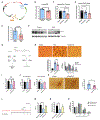Fasting-mimicking diet cycles reduce neuroinflammation to attenuate cognitive decline in Alzheimer's models
- PMID: 36170815
- PMCID: PMC9648488
- DOI: 10.1016/j.celrep.2022.111417
Fasting-mimicking diet cycles reduce neuroinflammation to attenuate cognitive decline in Alzheimer's models
Abstract
The effects of fasting-mimicking diet (FMD) cycles in reducing many aging and disease risk factors indicate it could affect Alzheimer's disease (AD). Here, we show that FMD cycles reduce cognitive decline and AD pathology in E4FAD and 3xTg AD mouse models, with effects superior to those caused by protein restriction cycles. In 3xTg mice, long-term FMD cycles reduce hippocampal Aβ load and hyperphosphorylated tau, enhance genesis of neural stem cells, decrease microglia number, and reduce expression of neuroinflammatory genes, including superoxide-generating NADPH oxidase (Nox2). 3xTg mice lacking Nox2 or mice treated with the NADPH oxidase inhibitor apocynin also display improved cognition and reduced microglia activation compared with controls. Clinical data indicate that FMD cycles are feasible and generally safe in a small group of AD patients. These results indicate that FMD cycles delay cognitive decline in AD models in part by reducing neuroinflammation and/or superoxide production in the brain.
Trial registration: ClinicalTrials.gov NCT05480358.
Keywords: Alzheimer’s disease; CP: Metabolism; CP: Neuroscience; NADPH oxidase; amyloid beta; fasting; fasting-mimicking diet; hyperphosphorylated tau; microglia; neuroinflammation; protein restriction; superoxide.
Copyright © 2022 The Authors. Published by Elsevier Inc. All rights reserved.
Conflict of interest statement
Declaration of interests V.D.L. has equity interest in L-Nutra, which develops and sells medical food for the prevention and treatment of diseases. A patent on this work has been filed by the University of Southern California, which has equity interest in L-Nutra (Fasting-mimicking Diet (FMD) as an Intervention for Alzheimer’s Disease (AD), US 62/840,762, Filed Apr 15, 2019).
Figures







References
-
- Alves S, Churlaud G, Audrain M, Michaelsen-Preusse K, Fol R, Souchet B, Braudeau J, Korte M, Klatzmann D, and Cartier N (2017). Interleukin-2 improves amyloid pathology, synaptic failure and memory in Alzheimer’s disease mice. Brain 140, 826–842. - PubMed
-
- Anderson AJ, Cummings BJ, and Cotman CW (1994). Increased immunoreactivity for Jun- and Fos-related proteins in Alzheimer’s disease: association with pathology. Exp. Neurol 125, 286–295. - PubMed
Publication types
MeSH terms
Substances
Associated data
Grants and funding
LinkOut - more resources
Full Text Sources
Medical
Molecular Biology Databases
Miscellaneous

